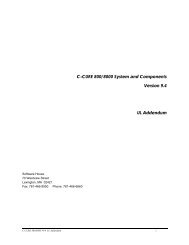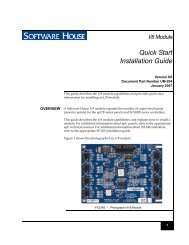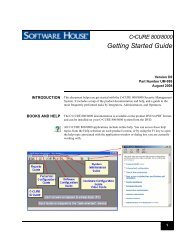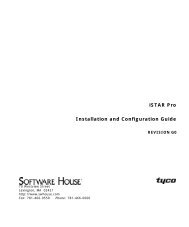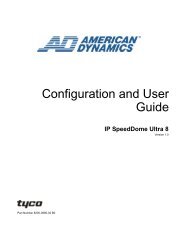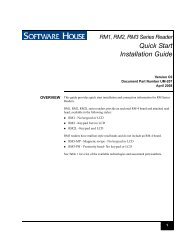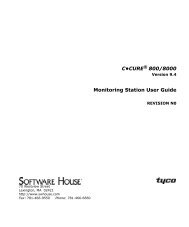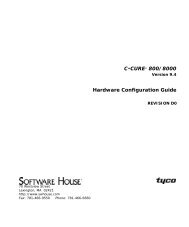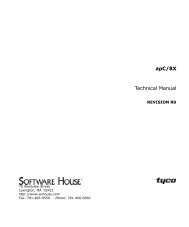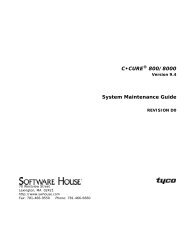Enhanced Password Protection Installation and Configuration Guide
Enhanced Password Protection Installation and Configuration Guide
Enhanced Password Protection Installation and Configuration Guide
- No tags were found...
Create successful ePaper yourself
Turn your PDF publications into a flip-book with our unique Google optimized e-Paper software.
Overview<br />
Overview<br />
C•CURE <strong>Enhanced</strong> <strong>Password</strong> <strong>Protection</strong> is a separate installation process that<br />
upgrades the existing C•CURE 800/8000 system installation. This allows a<br />
base system to be installed <strong>and</strong> tested before applying enhanced security<br />
features.<br />
C•CURE <strong>Enhanced</strong> <strong>Password</strong> <strong>Protection</strong> provides the ability to do both of the<br />
following:<br />
• Validate C•CURE users <strong>and</strong> allow access to valid users only.<br />
• Secure unused or idle workstations.<br />
Previously, C•CURE 800/8000 applications used only traditional<br />
authentication, presenting a login screen at startup. The traditional method<br />
allows you to create a single, st<strong>and</strong>ard username <strong>and</strong> password that all<br />
C•CURE 800/8000 users can use as their validation for C•CURE 800/8000<br />
applications. This approach, however, is not practical in organizations<br />
requiring greater security because users must log in twice to use C•CURE<br />
800/8000:<br />
• Once—through the Windows logon method.<br />
• For a second time—into the C•CURE application.<br />
C•CURE <strong>Enhanced</strong> <strong>Password</strong> <strong>Protection</strong> solves both the security <strong>and</strong><br />
multiple login issues by requiring each user to be uniquely identified within<br />
the operating system. When a defined user logs onto the computer, the<br />
C•CURE system then applies the user’s Windows username to validate the<br />
user within C•CURE 800/8000 <strong>and</strong> assign privileges to that user.<br />
Using the operating system for account management also provides additional<br />
features such as password aging, account lockout, <strong>and</strong> complexity rules.<br />
Once C•CURE <strong>Enhanced</strong> <strong>Password</strong> <strong>Protection</strong> is implemented, the C•CURE<br />
800/8000 applications no longer present the login screen at startup. C•CURE<br />
800/8000 applications open only when a defined C•CURE 800/8000 user logs<br />
onto the computer with C•CURE <strong>Enhanced</strong> <strong>Password</strong> <strong>Protection</strong>. It is,<br />
therefore, essential that all users who require access to C•CURE 800/8000<br />
have a Windows user account matching their C•CURE 800/8000 user<br />
account.<br />
<strong>Enhanced</strong> <strong>Password</strong> <strong>Protection</strong> <strong>Installation</strong> <strong>and</strong> <strong>Configuration</strong> <strong>Guide</strong> 1–3



